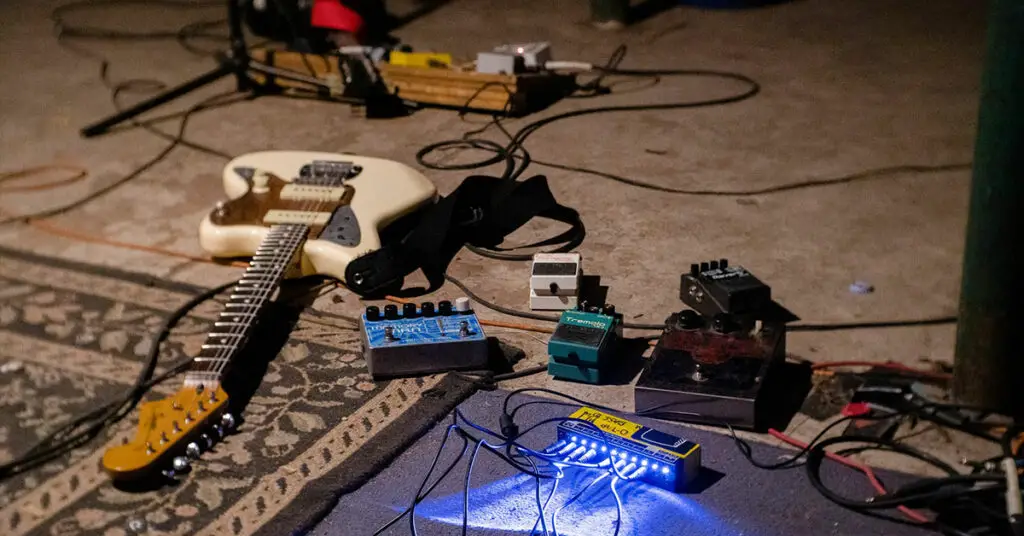Your search for the best left-handed Kramer Guitars end here!
Kramer guitars have been around since the 1970s. The first models were introduced in 1976 and became a catalyst for innovation.
When the Floyd Rose tremolo system was created, Kramer was the only guitar company offering that system. This gave Kramer an advantage over their competitors and skyrocketed their sales during the 1980s.
Kramer also installed Seymour Duncan pickups in their guitars and used a “banana” headstock design. By 1985, Kramer was the best-selling guitar company.
They became an instant American favorite and were promoted by famous rockstars, like Eddie Van Halen.
As of now, there are many Kramer guitars to choose from. You can even buy left-handed Kramer guitars.
Although Kramer does not offer many left-handed guitars, the options they do have are of superb quality. We’ll take a close look at these legendary and high-quality guitars!
Table of Contents
A Gift and a Curse
Why is it that so many gifted guitarists are left-handed, yet left-handed guitars are few and far between? This is the paradox present in the life of such guitarists. It is simultaneously a gift and a curse.
We have all probably heard that left-handed people are smarter. Although this is not entirely accurate, there is some level of truth to this statement.
Hand preference has a direct connection to cognition. This means that right-handed people usually have left-hemisphere-dominant brains, while left-handed people have a more developed right-hemisphere.
The right side of the brain is known as the “creative” side. Though it is not true that only the right side of the brain is responsible for creativity, it does strongly help with creative functions. The right side of the brain is responsible for spatial reasoning, holistic thinking, imagination, nonverbal cues, and rhythm.
It is this artistic flair that many lefties possess which might give them an advantage over right-handed musicians.
Since lefties are right dominant, they perceive sound differently. In general, lefties perceive sound slower which allows them to pick up on nuances that righties might have missed.
In addition, a study from the National Institute of Sports and Physical Education in Paris showed that left-handed people have faster eye-hand coordination with both hands than right-handed people. This is surely an advantage when playing music, especially guitar.
Most often than not, left-handed people are forced to adapt to a world made for right-handed people. This is where the challenge comes in particularly for musicians.
Left-handed musicians have to deal with chord charts designed for right-handed people among other monstrosities. Most left-handed guitarists simply have no choice but to switch the strings on a right-handed guitar.
At the same time, it’s overcoming these challenges that gives left-handed musicians an advantage. There is a theory which suggests that because left-handed people are forced to adapt to a right-handed world, they have increased connectivity between the two hemispheres of the brain.
This increased connectivity might be the reason why so many left-handed people are gifted in some way.
It is this unique combination of advantages and disadvantages that made many left-handed guitarists (Jimi Hendrix, Kurt Cobain, Paul McCartney, etc.) so great.
Right-handed Guitar vs. Left-handed Guitar
What makes a left-handed guitar different? You can easily spot the difference if you hold the guitar vertically.
What you will notice right away is the position of the strings. On a left-handed guitar, the thickest string will be on the right side, while on a right-handed guitar it’s vice versa.
Another way to spot the difference is to pay close attention to the pickguard. The pickguard is a thin piece of material placed on the body of a guitar to protect it from scratches.
Usually, when you face a right-handed guitar the pickguard will appear on the right side of the guitar. If the pickguard appears on the left side, then there is a good chance that the guitar is left-handed.
You can also take note of the fretboard inlays, guitar nut, strap button, and saddle angle. All these parts should be reversed or flipped on a left-handed guitar.
In many respects, left-handed guitars are completely equal to right-handed guitars. The main difference is the disproportionate number of left-handed guitars available in comparison to right-handed guitars.
Many guitarists ditch left-handed guitars altogether and simply play right-handed guitars upside down. Obviously, the downside to this is that there is barely any learning material for this way of playing.
Some also argue that playing a guitar upside down creates an error in the string length compensation. This means that the guitar will not be in tune in both the lower and higher registers.
One way to get around this is to play only within a certain range. However, this can be extremely restrictive.
Whether you decide to invest in a left-handed guitar or play a right-handed guitar upside down, you can surely make it work out.
Left-handed guitarists have pulled through and displayed their genius to the world, and will continue to do so for years to come.
Besides, just because you are left-handed does not mean playing guitar left-handed is what comes natural to you.
You might prefer to write with your left hand, but play guitar right-handed. Afterall, we are not fully right dominant or left dominant.
Left-handed Kramer Guitars
As promised before, we’ll go over the left-handed Kramer guitar options. Currently, Kramer offers two left-handed guitars.
Though it is a limited number of options, both guitars are a great choice for left-handed players. Below is an in depth description of the two left-handed Kramer guitars:
1. Kramer Pacer Classic Left-handed Electric Guitar
- Body Type: Solidbody
- Body Shape: Pacer Classic
- Body Material: Alder
- Body Finish: Gloss
- Neck Material: Naple
- Neck Shape: K-Speed SlimTaper C
- Neck Joint: Bolt-on
- Radius: 12”
- Fingerboard Material: Maple
- Fingerboard Inlay: Black Dots
- Number of Frets: 22
- Scale Length: 25.5”
- Nut Width: 1.626”
- Nut Material: Licensed Floyd Rose R2 Locking
- Bridge: Licensed Floyd Rose Locking Tremolo
- Tuners: Die-cast
- Neck Pickup: Alnico 5 Classic White Humbucker
- Bridge Pickup: Alnico 5 Classic White Humbucker
- Controls: 2 Volume, Master Tone
- Pickup Selector: 3-way Mini Toggle
- Output Jack: 1/4”
- Number of Strings: 6
- Colors: Radio Blue Metallic, Scarlet Red Metallic, Purple Passion Metallic
The Pacer Classic is inspired by Kramer’s 1980s shred-style guitar. Its K-Speed SlimTaper C neck shape makes the Pacer Classic a guitar built for speed. Likewise, its 12 inch fingerboard makes for incredibly fast playability.
The Pacer Classic guitar has an alder body with a scale length of 25.5 inches and 22 total frets. It delivers a balanced sound throughout the high, middle, and low ranges.
Another great feature of the Pacer Classic is its amazing electronics. The Pacer Classic features an Alnico 5 Classic Humbucker pickup. The pickup is the heart of every electric guitar.
It is what converts string vibrations into electricity. The Alnico 5 pickup does its job extremely well. It creates an incredibly aggressive and striking sound!
The Pacer Classic also features a 3-way toggle switch, which is what determines which pickup will transfer the string vibrations into electricity. A 3-way toggle switch works by only connecting one terminal at a time.
In addition, the Pacer Classic includes independent volume knobs for each pickup and a master tone control. These features allow players direct control of how they want their guitar to sound.
The Pacer Classic guitar features a Floyd Rose tremolo system. The tremolo system allows you to change the pitch of the strings. One of the great advantages of a Floyd Rose tremolo system is the double-locking feature.
The double-locking feature helps the guitar remain in tune as the pitch changes.
You can get the Pacer Classic guitar in one of three bold colors: radio blue metallic, scarlet red metallic, and purple passion metallic. Best of all, the Pacer Classic guitar is extremely affordable at only $379!
Price: $379
2. Kramer Nightswan Left-handed Electric Guitar
- Body Type: Solidbody
- Body Shape: Nightswan
- Body Material: Mahogany
- Body Finish: Gloss
- Neck Material: Hard Maple
- Neck Shape: C
- Neck Joint: Bolt-on
- Radius: 16”
- Fingerboard Material: Ebony
- Fingerboard Inlay: Pearloid Dots
- Number of Frets: 24
- Scale Length: 24.75”
- Nut Width: 1.625”
- Nut Material: Floyd Rose R2 Locking
- Bridge: Floyd Rose 1000 Series Locking Tremolo
- Tuners: Kramer Deluxe
- Neck Pickup: Seymour Duncan JB
- Bridge Pickup: Seymour Duncan JB
- Controls: Master Volume
- Pickup Selector: 3-way Paddle Mini Toggle
- Output Jack: Black Barrel, Rim Mount
- Number of Strings: 6
- Colors: Jet Black Metallic, Black with Blue Polka Dot, Vintage White with Aztec Graphic
The Kramer Nightswan is another incredible guitar designed from the 1980s. Similar to the Pacer Classic, the Nightswan was also built for speed. Its unique C-shaped neck and 16 inch fingerboard ensure fast playability.
The Nightswan features a double-cutaway mahogany body with a scale length of 24.75 inches and 24 total frets. The Nightswan’s fingerboard displays a beautiful pearloid dot inlay in a unique “ping pong” pattern.
The Seymour Duncan JB pickup on the Nightswan is a legendary pickup used on countless albums. It was used by Steve Stevens, Jake E. Lee, and even Jerry Cantrell from Alice In Chains.
The Seymour Duncan JB pickup creates that classic hard rock sound we all know and love.
The Nightswan features a Floyd Rose double-locking tremolo system. The double-locking system allows you to mess with the pitch as much as you want without the Nightswan going out of tune.
The Kramer Nightswan also includes a 3-way pickup toggle and a volume knob. It is available in three striking designs: jet black metallic, black with blue polka dot, and vintage white with Aztec graphic.
Price: $899
Alternatives
If you’d like to consider other options, here is a quick list of some accessible left-handed electric guitars:
1. LyxPro Full-Sized 39” Electric Guitar Kit for Left-handed Beginners
- Canadian Maple
- Wood Body
- Maple Neck
- 39”
- 20W Amplifier
- 6-string
- 2 Picks
- Tremolo Bar
- Shoulder Strap
- Carrying Bag
- 11.6” x 11.2” x 4.1”
- 5.7 lbs.
The LyxPro 39” electric guitar includes a kit with everything you need to start playing. It is an excellent and affordable guitar for beginners.
The guitar comes with a digital tuner that ensures your guitar is always in tune. The kit also includes a 20 watt amplifier with cable. The amplifier has a built-in speaker, headphone jack, and aux input.
This LyxPro electric guitar is one of the most accessible and comfortable guitars for beginners. Best of all, it is for left-handed players!
Price: $149
2. Yamaha Pacifica PAC112JL YNS Left-handed Electric Guitar
- Maple Material
- Alder Body
- Rosewood Fretboard
- Vintage Tremolo
- 5 Position Switch
- 42.76” x 17.99” x 4.49”
- 10.30 lbs.
The Yamaha Pacifica is a high-quality left-handed guitar that will not break your wallet. The guitar provides great tone and amazing playability.
It has a vintage-style tremolo bridge and maple neck with a rosewood fretboard. It also includes a humbucker pickup in the bridge with 2 single coils.
The Yamaha Pacifica is available in many colors including yellow, blue, red, and black.
Price: $271
3. Grote Full Scale Left-handed Electric Guitar
- Maple Material
- Maple Body
- Blackwood Fretboard
- 24.75”
- 22 Frets
- 42mm Nut Width
The Grote full scale left-handed electric guitar is a beautiful semi-hollow guitar. It has a vintage sunburst color which makes it an attractive option.
The tuner and strap are both excellent. The guitar also comes with an extra set of strings and picks.
Overall, this Grote guitar is a great choice if you are looking for a strat-style guitar.
Price: $199
4. Jackson JS22 Dinky Arch Top DKA Left-handed Electric Guitar
- Maple Material
- Poplar Body
- 25.5” Scale Length
- 24 Frets
- 2-Point Fulcrum Tremolo
- 1.625” Nut Width
- 3-way Pickup Switch
- 6-string
- Black Color
The Jackson JS22 DKA has a poplar body with arched top and a bolt-on maple neck. The fingerboard has a 12”-16” compound radius, which is ideal for fast playing.
The humbucker pickups produce a clear tone with lots of girth. The Jackson JS22 DKA also includes a 3-way toggle switch with volume and tone controls.
The guitar is available in a striking gloss black color with a synchronized fulcrum tremolo bridge. It also includes standard strap buttons and die-cast tuners.
Price: $239
Final Words
Although there aren’t as many left-handed guitars as we would hope for, the ones on this list are exceptional.
We can only hope that as the next generation of great left-handed guitarists emerge, more left-handed guitars will be introduced into the market for all of us to enjoy.



![HERE’S What Happened to the Soul Singer Al Green [2023 Update]](https://performerlife.com/wp-content/uploads/2023/04/what-happened-to-al-green-211x150.jpg)
